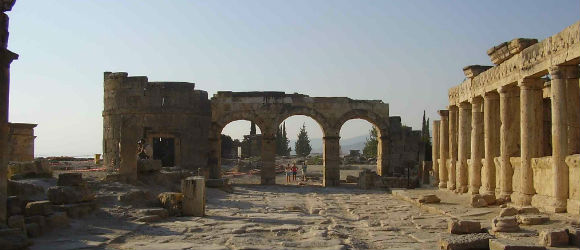The presence of a hot spring at Hierapolis and the spectacular calcium deposits from its water spilling over the nearby hillside suggest that there should be evidence of an early settlement there. The oldest Inscription found so far, however, indicates it was founded by Eumenes II, king of Pergamon, in the latter part of the second century B.C.; it soon became a busy industrial center.
Pagan worship in the city centered around Cybele, Apollo, Artemis, Men, Poseidon, and Pluto. Underneath the Temple of Apollo has been found the Plutonium, an opening in the earth from which a noxious gas still comes. The temple is between the pool where the hot spring rises and the large theater on the side of the hill. To the north along the rim of the plateau is a long avenue of tombs.
Traditionally St. Philip is connected with the early church in Hierapolis. Fairly recently Italian archeologlsts have discovered his Martyrium, an octagonal chamber forming a double cross surrounded by a square. This is almost due north of the theater, also on the side of the hill. It was a fifth century A.D. building and did not last much more than 100 years. No tomb was found with it although that was expected. There are several ruins of churches, one not far from the baths, one on the main road leading to the necropolis.
Hierapolis is listed in the New Testament along with Laodicea as the center of Epaphras’s work (Colos-sians 4:13). This was at the time Paul was writing to strengthen the message Epaphras was preaching and to condemn the “people who go in for self-mortification and angel-worship” (Colossians 2:18). Another less well-known resident of Hierapolis was Papias, a disciple of St. John and the author of the lost book called the Sayings of Jesus.
While Epaphras was is that area, a young slave was growing up in Hierapolis, a boy whose original name is unknown but whom we call by the Greek for “Acquired”, Epictetus. In his Discourses Epictetus often talks about the perfect missionary whose bed was the ground, whose only house the earth and sky and a shabby cloak, and who must love those who misuse him in the service of God. One wonders what the influence of those early Christians, many of whom were slaves themselves, was on this Stoic philosopher.
Hierapolis,


I t is magnificient site to visit, I gurentee that your experience will be unique, and the feeling will be full of pleasure with natural beautity coupled with the ancient greco-Roman history.
Once you become part of history, you never want to return home !
good museum, very well preserved roman theatre, worth a visit, staying in town overnight is skippable so try to make this a day trip
Although you have to spend more than 5-6 hours only by way, you will not be disappointed by that place with a lot of pieces full of history that are very well conserved. Be aware when you choose the guide. We paid a guide who run with our groups and finally I choose to walk by my account.
I stayed 2 nights in Pamukkale so I could have a full day at the site without having to hurry off to a bus. I'm glad I did. The town is shabby and mildly exploitative (just desperate for tourist income really), but at 30 TRY per night for a double room it was worth it (I stayed at Dort Mevsim…
Be sure to do your homework before visiting Hierapolis & Pamukkale. Please be very aware that Pamukkale does not look anything like the pictures you continue to see in travel books, travel agencies and even travel agencies in Turkey. They still are misleading tourists with photos that were taken over 20 years ago before Pamukkale got classified as a World…
Took a bus tour from Selcuk (about 3 hours) and was looking forward to cooling off in the man-made travertines. Unfortunately, hundreds of other tourists had the same idea. It was absolutely crowded, so our dip turned into a brief paddle.
The other travertines seemed as though they had lost some of their lustre, when compared to the photos in…
I was blown away by the place ; I had the chance to go there for job purposes, accompanied by cool turk people; It's beautiful and such a unique experience. The wonder of nature mixed by the wonder of history and culture; what else can you ask?
it worths to visit but only in september because it is very, very hot in july and august.
but it is very interesting!
Its a marvel whih can only be explained and experienced by going there yourself
Just accross the Pamukkale thermal pools you'll find the ruins of ancient greek city of Hierapolis. The ruins are in good conditions and a visit becomes a very interesting one, a World Heritage appointed by Unesco since 1988. Your visit to the Pamukkale area wouldn't be complete without some hours in Hierapolis. Enjoy!